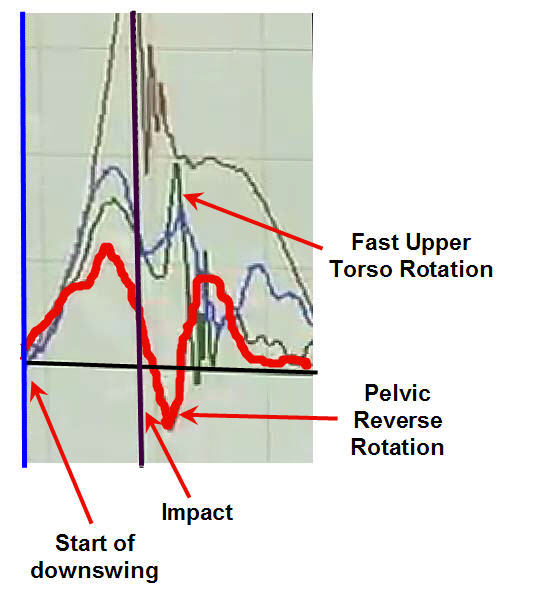Post by imperfectgolfer on Nov 25, 2023 11:14:27 GMT -5
In this post, I am going to compare the pivot motion technique taught by Milo Lines versus the "standard" pivot motion technique.
Milo Lines has produced a fair number of videos on how to rotate the pelvis and upper body during the downswing and early followthrough, and the following video is a good explanatory example of his thinking.
I have made capture images of his pivot motion-demonstration seen in the video, and I will use these capture images to comment on his conceptual approach.



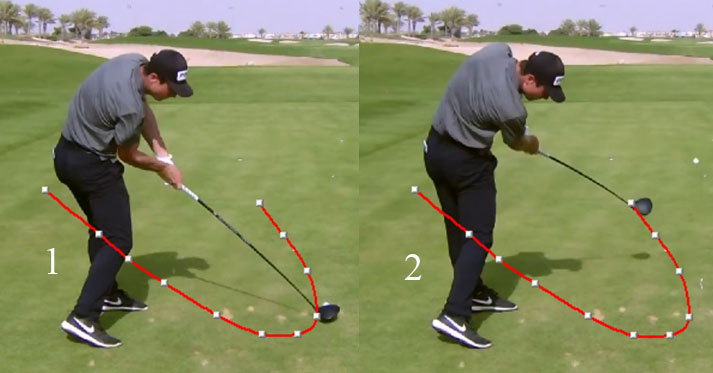
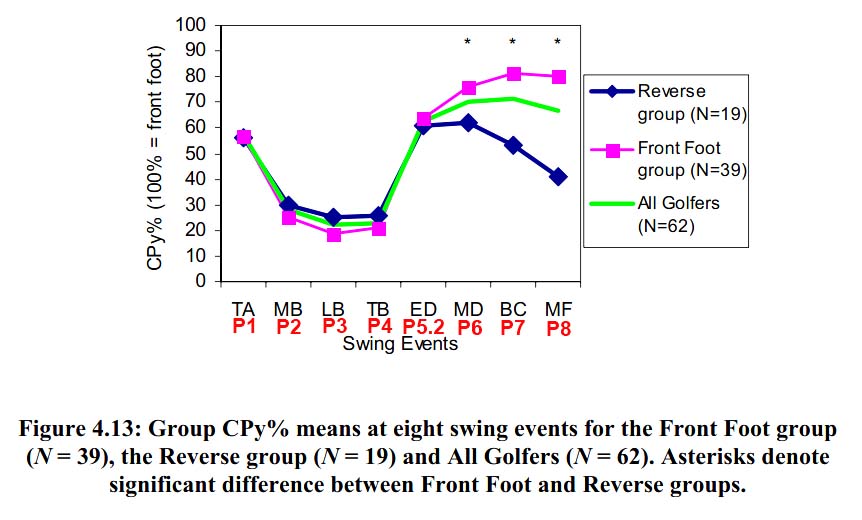
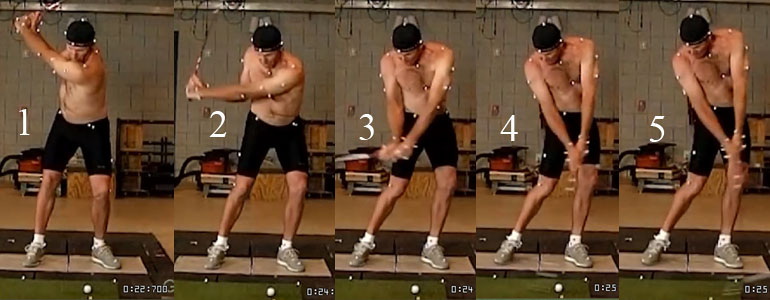
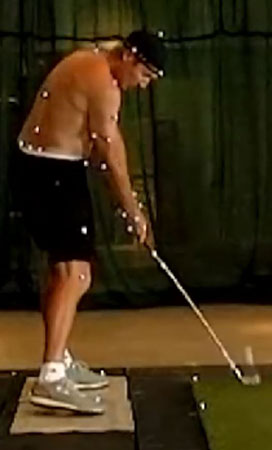


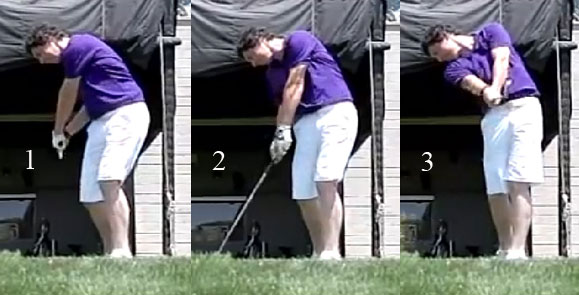
Milo Lines has produced a fair number of videos on how to rotate the pelvis and upper body during the downswing and early followthrough, and the following video is a good explanatory example of his thinking.
I have made capture images of his pivot motion-demonstration seen in the video, and I will use these capture images to comment on his conceptual approach.

Image 1 shows Milo at his P4 position. Note that he has placed a rod through his trouser belt loops and its change in angular displacement is reflective of his degree of pelvic rotation.
Image 2 is at his P5 position. Note that Milo favors an overt squat motion involving an increased degree of hip joint flexion during the hip-squaring action that is happening between P4 => P5, and that causes his head to drop as he acquires an increased degree of anterior pelvic tilt. Milo deliberately wants to avoid any pelvic sway motion to the left during his hip-squaring phase and he basically prefers the "idea" that the pelvis motion must be perceived to primarily be a rotary motion, and not a shift-rotation motion. Milo also does not want to spin the pelvis in the early downswing, which would cause the trail pelvis to prematurely leave the tush line and potentially block the space in front of the trail hip joint area where he plans to position his trail elbow by P5.5. Milo talks about the "feel" of the pelvis moving back away from the ball-target line as he squats and acquires an increased degree of anterior pelvic tilt during the early downswing, which means that he is definitely avoiding any possibility of acquiring the swing fault of early extension due to a pelvic thrust motion towards the ball-target line. Another point about his recommended pelvic motion technique is that he does not want to acquire too much torso-pelvic separation (dynamic X-factor) during the early downswing and he wants a golfer to start turning the upper torso counterclockwise very soon after he starts transitioning into the downswing.
Image 3 is at the P5.5 position where he has continued to rotate his pelvis counterclockwise to a marginally open position. Note how easily he manages to get his trail elbow into a desirable pitch location just in front of his trail hip joint area by P5.5. Note that he is still maintaining a large degree of anterior pelvic tilt at P5.5 and that creates a potential space in front of his trail hip area for the pitch location positioning of his trail elbow.
Image 4 is just after P7 (as there was no frame at impact in the video) and image 5 is at P7.5+. Note how Milo continues to actively rotate his pelvis counterclockwise between P5.5 => P7.5+ so that he has a very open pelvis alignment at impact and also during his early followthrough. Another golf instructional point that Milo emphasises is that he wants to rotate the upper torso at roughly the same speed as the pelvis during the later downswing and early followthrough and he talks of the "feel" of the "upper chest covering the ball" during the later downswing. One major advantage of Milo's firm recommendation to keep the upper torso rotating actively with the pelvis during the P5.5 => P7+ time period is that it gets the trail shoulder socket further downplane so that he does not "run-out-of-trail arm" by P7 - note how easily Milo can maintain a slightly bent trail arm and a partially extended trail wrist at P7. Another major advantage of having such an active pelvis/upper torso rotation that gets both the pelvis and upper torso significantly open by P7 is that it more easily allows a golfer to get his hands ahead of the ball at impact thereby ensuring the presence of a desirable amount of forward shaft lean. By continuing to actively rotate the pelvis/upper torso counclockwise between P7 => P7.4 it also makes it more easy for a golfer to perform a DH-hand release action between P7 => P7.4.
I will emphasize some of these same points when analysing these capture images of Milo's driver golf swing action.
Image 2 is at his P5 position. Note that Milo favors an overt squat motion involving an increased degree of hip joint flexion during the hip-squaring action that is happening between P4 => P5, and that causes his head to drop as he acquires an increased degree of anterior pelvic tilt. Milo deliberately wants to avoid any pelvic sway motion to the left during his hip-squaring phase and he basically prefers the "idea" that the pelvis motion must be perceived to primarily be a rotary motion, and not a shift-rotation motion. Milo also does not want to spin the pelvis in the early downswing, which would cause the trail pelvis to prematurely leave the tush line and potentially block the space in front of the trail hip joint area where he plans to position his trail elbow by P5.5. Milo talks about the "feel" of the pelvis moving back away from the ball-target line as he squats and acquires an increased degree of anterior pelvic tilt during the early downswing, which means that he is definitely avoiding any possibility of acquiring the swing fault of early extension due to a pelvic thrust motion towards the ball-target line. Another point about his recommended pelvic motion technique is that he does not want to acquire too much torso-pelvic separation (dynamic X-factor) during the early downswing and he wants a golfer to start turning the upper torso counterclockwise very soon after he starts transitioning into the downswing.
Image 3 is at the P5.5 position where he has continued to rotate his pelvis counterclockwise to a marginally open position. Note how easily he manages to get his trail elbow into a desirable pitch location just in front of his trail hip joint area by P5.5. Note that he is still maintaining a large degree of anterior pelvic tilt at P5.5 and that creates a potential space in front of his trail hip area for the pitch location positioning of his trail elbow.
Image 4 is just after P7 (as there was no frame at impact in the video) and image 5 is at P7.5+. Note how Milo continues to actively rotate his pelvis counterclockwise between P5.5 => P7.5+ so that he has a very open pelvis alignment at impact and also during his early followthrough. Another golf instructional point that Milo emphasises is that he wants to rotate the upper torso at roughly the same speed as the pelvis during the later downswing and early followthrough and he talks of the "feel" of the "upper chest covering the ball" during the later downswing. One major advantage of Milo's firm recommendation to keep the upper torso rotating actively with the pelvis during the P5.5 => P7+ time period is that it gets the trail shoulder socket further downplane so that he does not "run-out-of-trail arm" by P7 - note how easily Milo can maintain a slightly bent trail arm and a partially extended trail wrist at P7. Another major advantage of having such an active pelvis/upper torso rotation that gets both the pelvis and upper torso significantly open by P7 is that it more easily allows a golfer to get his hands ahead of the ball at impact thereby ensuring the presence of a desirable amount of forward shaft lean. By continuing to actively rotate the pelvis/upper torso counclockwise between P7 => P7.4 it also makes it more easy for a golfer to perform a DH-hand release action between P7 => P7.4.
I will emphasize some of these same points when analysing these capture images of Milo's driver golf swing action.

Image 1 is at P6, image 2 is at P6.5, image 3 is at P7, image 4 is at P7.4 and image 5 is at P7.8.
Note how actively Milo continues to rotate his pelvis/upper torso counterclockwise between P6 => P7.4+. Note how he manages to get his hands well forward at impact so that he has a small degree of forward shaft lean at impact. Also, note how he still has a bent trail arm and a significantly extended trail wrist at impact, which I think is potentially advantageous because it allows the trail hand to work as a negative hand couple through impact thereby contributing to an increased degree of mechanical stability of the lead wrist through the impact zone. Note how easily/efficiently he can perform a DH-hand release action between P7 => P7.4, which allows him to keep his clubface square to his clubhead path all the way between P7 => P7.4.
I personally think that Milo's personal pivot motion is an excellent biomechanical way to perform a pivot motion that leads to many positive benefits (as described).
I think that the pro golfer who best exemplifies the same basic pivot motion pattern as seen in Milo's driver golf swing action is Viktor Hovland.
Here are capture images of Viktor Hovland's driver golf swing action.
Note how actively Milo continues to rotate his pelvis/upper torso counterclockwise between P6 => P7.4+. Note how he manages to get his hands well forward at impact so that he has a small degree of forward shaft lean at impact. Also, note how he still has a bent trail arm and a significantly extended trail wrist at impact, which I think is potentially advantageous because it allows the trail hand to work as a negative hand couple through impact thereby contributing to an increased degree of mechanical stability of the lead wrist through the impact zone. Note how easily/efficiently he can perform a DH-hand release action between P7 => P7.4, which allows him to keep his clubface square to his clubhead path all the way between P7 => P7.4.
I personally think that Milo's personal pivot motion is an excellent biomechanical way to perform a pivot motion that leads to many positive benefits (as described).
I think that the pro golfer who best exemplifies the same basic pivot motion pattern as seen in Milo's driver golf swing action is Viktor Hovland.
Here are capture images of Viktor Hovland's driver golf swing action.

The red splined path represents his hand arc path.
Image 1 is at P4, image 2 is at P5, image 3 is at P5.5, image 4 is at P6 and image 5 is at impact.
VH has a rightwards-centralised upper torso loading pattern at P4, while Milo's upper torso is slightly more centralised at his P4 position.
Note how VH squats during his hip-squaring action between P4 => P5, and that causes his head to drop as he acquires a greater degree of anterior pelvic tilt.
Note how VH continues to actively rotate his pelvis between P5 => P7 and how his active upper torso rotation (that is combined with a large degree of right lateral bend) allows him to get his trail shoulder well downplane by P7 - so that he very easily gets to impact with his hands well forward of the ball, which ensures the presence of forward shaft lean at impact. Note that VH's trail arm is still partially bent and that his trail wrist is still significantly extended at impact and that he has avoided a "running-out-of-trail arm" scenario.
Here are capture images of VH's followthrough action.
Image 1 is at P4, image 2 is at P5, image 3 is at P5.5, image 4 is at P6 and image 5 is at impact.
VH has a rightwards-centralised upper torso loading pattern at P4, while Milo's upper torso is slightly more centralised at his P4 position.
Note how VH squats during his hip-squaring action between P4 => P5, and that causes his head to drop as he acquires a greater degree of anterior pelvic tilt.
Note how VH continues to actively rotate his pelvis between P5 => P7 and how his active upper torso rotation (that is combined with a large degree of right lateral bend) allows him to get his trail shoulder well downplane by P7 - so that he very easily gets to impact with his hands well forward of the ball, which ensures the presence of forward shaft lean at impact. Note that VH's trail arm is still partially bent and that his trail wrist is still significantly extended at impact and that he has avoided a "running-out-of-trail arm" scenario.
Here are capture images of VH's followthrough action.

The red splined path is his clubhead path.
Image 1 is at P7 and image 2 is at P7.4.
Note that VH is performing a CP-arm release action (where his lead hand moves inside-left very efficiently between P7 => P7.4) that is combined with a DH-hand release action (that allows him to keep his clubface square to his clubhead path between P7 => P7.4).
Milo aspires to perform a CP-arm release action like VH where his hands/club can move significantly inside-left during his early followthrough, but he admits that he does not have the flexibility to perform it as well as Ben Hogan (or) VH in the following video - see between the 6:19 - 6:34 time point of the following video.
Image 1 is at P7 and image 2 is at P7.4.
Note that VH is performing a CP-arm release action (where his lead hand moves inside-left very efficiently between P7 => P7.4) that is combined with a DH-hand release action (that allows him to keep his clubface square to his clubhead path between P7 => P7.4).
Milo aspires to perform a CP-arm release action like VH where his hands/club can move significantly inside-left during his early followthrough, but he admits that he does not have the flexibility to perform it as well as Ben Hogan (or) VH in the following video - see between the 6:19 - 6:34 time point of the following video.
If you look at Milo's/VH's lead leg through impact, you will note that they do not straighten their lead leg fully (like Tiger Woods or Ian Poulter or Rory McIlroy) at impact, or just post-impact, and I strongly suspect that they could both be reverse-foot golfers.
I first became aware of the differences between a reverse-foot golfer and a front-foot golfer when I saw this image in a PhD thesis paper by Kevin Ball.
I first became aware of the differences between a reverse-foot golfer and a front-foot golfer when I saw this image in a PhD thesis paper by Kevin Ball.

Kevin Ball did a research study where he measured the COP (center-of-pressure) under the lead foot and trail foot during the downswing. The above graph shows the COP measurement under the lead foot.
He noted in his study of 62 golfers that they only had 20-30% of their COP measurement under their lead foot at P4. During the downswing, some of those golfers steadily increased the COP measurement under their lead foot to a maximum value of ~80% at impact and he called those golfers "front-foot golfers". By contrast, there was another subgroup of golfers who increased the COP measurement under their lead foot in the early downswing to its maximum value at ~P5.2 and that they then decreased their COP measurement under their lead foot between P5.2 => P7, and he called that subgroup of golfers "reverse-foot" golfers.
I do not have the COP measurements of VH, but I have seen Milo's COP measurements. As a rough approximation, I suspect that Milo has ~85% of his overall COP measurement under his lead foot at P5.2, and about 60 - 70% at impact and <60% at P7.4. If I am correct in my estimation of his COP-measurements, that makes Milo a "reverse foot" golfer who is decreasing the COP-measurement under his lead foot between P5.2 => P7+. Why could this be important? I think that it can potentially be much easier to biomechanically rotate one's pelvis, while maintaining a high degree of anterior pelvic tilt (like Milo and VH), between P5 => P7 if one is a reverse-foor golfer, and not a front foot golfer. I think that a front-foot golfer is not going to be able to rotate the pelvis very efficiently like Milo/VH who rotate their pelvis counterclockwise between P5.5 => P7 while maintaining a high degree of anterior pelvic tilt. I suspect that it is much easier for a front-foot golfer to perform the "standard" pivot motion.
A good example of a front-foot golfer is Grant Waite who gets >80% of his COP-measurement under his lead foot by impact.
Here is a video of Grant Waite's golf swing action.
He noted in his study of 62 golfers that they only had 20-30% of their COP measurement under their lead foot at P4. During the downswing, some of those golfers steadily increased the COP measurement under their lead foot to a maximum value of ~80% at impact and he called those golfers "front-foot golfers". By contrast, there was another subgroup of golfers who increased the COP measurement under their lead foot in the early downswing to its maximum value at ~P5.2 and that they then decreased their COP measurement under their lead foot between P5.2 => P7, and he called that subgroup of golfers "reverse-foot" golfers.
I do not have the COP measurements of VH, but I have seen Milo's COP measurements. As a rough approximation, I suspect that Milo has ~85% of his overall COP measurement under his lead foot at P5.2, and about 60 - 70% at impact and <60% at P7.4. If I am correct in my estimation of his COP-measurements, that makes Milo a "reverse foot" golfer who is decreasing the COP-measurement under his lead foot between P5.2 => P7+. Why could this be important? I think that it can potentially be much easier to biomechanically rotate one's pelvis, while maintaining a high degree of anterior pelvic tilt (like Milo and VH), between P5 => P7 if one is a reverse-foor golfer, and not a front foot golfer. I think that a front-foot golfer is not going to be able to rotate the pelvis very efficiently like Milo/VH who rotate their pelvis counterclockwise between P5.5 => P7 while maintaining a high degree of anterior pelvic tilt. I suspect that it is much easier for a front-foot golfer to perform the "standard" pivot motion.
A good example of a front-foot golfer is Grant Waite who gets >80% of his COP-measurement under his lead foot by impact.
Here is a video of Grant Waite's golf swing action.
Here are capture images from the above video.
Face-on capture images
Face-on capture images

DTL capture image

Note that GW manifests many features of a "standard" pivot motion - i) the pelvis is only slightly open at impact and the upper torso is barely open at impact (and often parallel to the ball-target line at impact); ii) the trail shoulder is not that far downplane so that the trail arm will be less bent, and the trail wrist less extended, at impact and iii) the hands will be inside the lead thigh at impact; iv) the lead shoulder socket may be located over the lead foot at impact rather than being well behind the lead foot at impact (as seen in VH's/Milo's driver golf swing action) and v) the lead leg will be straighter and the lead hip joint will more likely be more vertically-aligned over the lead foot at impact.
Consider other features of a "standard" pivot motion type of golf swing action.
Capture images of Tiger Woods driver swing action.
Consider other features of a "standard" pivot motion type of golf swing action.
Capture images of Tiger Woods driver swing action.

Image 1 shows TW at impact and images 2,3 and 4 show his early followthrough action.
Note that TW's pelvis does not continue to rotate counterclockwise much between P7 => P7.4; that he "runs-out-of-trail arm" very soon after impact because his trail shoulder socket does not move far enough downplane; and that he is obliged to use a CF-arm release action during his followthrough that is combined with either a delayed full-roll subtype of DH-hand release action or a rolling subtype of non-DH hand release action.
Here is another pro golfer - Rory McIlroy - who uses the "standard" pivot motion technique.
Note that TW's pelvis does not continue to rotate counterclockwise much between P7 => P7.4; that he "runs-out-of-trail arm" very soon after impact because his trail shoulder socket does not move far enough downplane; and that he is obliged to use a CF-arm release action during his followthrough that is combined with either a delayed full-roll subtype of DH-hand release action or a rolling subtype of non-DH hand release action.
Here is another pro golfer - Rory McIlroy - who uses the "standard" pivot motion technique.

Image 1 is at P4, image 2 is at P4.5, image 3 is near P5, image 4 is at P6, image 5 is at impact and image 6 is after P8.
Note that Rory has a very fast pelvic shift-rotation motion between P4 => P6 where he acquires a lot of torso-pelvic separation, and that his pelvis is slightly open at P6. However, he then stalls his rotary pelvic motion and there is no further counterclockwise rotation of his pelvis during his later downswing and early followthrough. Note how he has a straightened lead leg at impact with his lead shoulder socket and lead hip joint near-vertically located over his lead foot at impact.
Here are capture images of Rory's early followthrough action - as seen from an upline viewing perspective.
Note that Rory has a very fast pelvic shift-rotation motion between P4 => P6 where he acquires a lot of torso-pelvic separation, and that his pelvis is slightly open at P6. However, he then stalls his rotary pelvic motion and there is no further counterclockwise rotation of his pelvis during his later downswing and early followthrough. Note how he has a straightened lead leg at impact with his lead shoulder socket and lead hip joint near-vertically located over his lead foot at impact.
Here are capture images of Rory's early followthrough action - as seen from an upline viewing perspective.

Image 1 is at P6, image 2 is at P7 and image 3 is at P8.
Note that he does not continue to actively rotate his pelvis counterclockwise between P7 => P8 and that he performs a CF-arm release action that is combined with a borderline delayed full-roll DH hand release action, or a rolling subtype of non-DH hand release action, between P7 => P8.
I suspect that 95% of pro golfers use the "standard" pivot motion technique and not the Milo Lines-taught pivot motion technique (which I think has certain biomechanical advantages)?
Why do they not use Milo's more rotary pivot motion technique?
I do not know the answer. It could be due to a number of factors eg. i) traditional pivot motion teaching passed along from each generation of golf instructors to later generations of golf instructors over the past 10+ decades; ii) a lack of flexibility that makes it too physically difficult to perform the Milo Lines-taught pivot motion with great ease/efficiency and iii) the fact that many pro golfers use a front-foot COP-pattern that may not be compatible with the Milo Lines-taught pivot motion technique.
From an individual student-golfer's perspective, who wants to consider whether he should use the Milo Lines-taught pivot motion technique, he first needs to discover whether he has the flexibility and biomechanical skills needed to perform the Milo Lines-taught pivot motion pattern in a consistently efficient manner. Unfortunately, I am not aware that Milo Lines has explored this issue and developed a series of biomechanical tests to determine whether each student-golfer has the flexibility-and-biomechanical skills needed to perform his recommended pivot motion technique in an efficient manner. Also, I do not believe that Milo has considered the possibility as to whether being a front-foot golfer (like Brendon Devore) makes it impossible, or very difficult, to efficiently perform his Milo Lines-taught pivot motion technique.
Finally, although I (= an amateur golf theorist) personally favors the Milo Lines-taught pivot motion technique from a purely theoretical perspective, it is important to realise that the world's greatest golf ball strikers (both in the past era and the present era) have obviously learned how to hit consistently accurate shots using the "standard" pivot motion technique. It may therefore be better for Brendon DeVore to use the "standard" pivot motion technique if he cannot ever master the Milo Lines-taught pivot motion technique.
Note that he does not continue to actively rotate his pelvis counterclockwise between P7 => P8 and that he performs a CF-arm release action that is combined with a borderline delayed full-roll DH hand release action, or a rolling subtype of non-DH hand release action, between P7 => P8.
I suspect that 95% of pro golfers use the "standard" pivot motion technique and not the Milo Lines-taught pivot motion technique (which I think has certain biomechanical advantages)?
Why do they not use Milo's more rotary pivot motion technique?
I do not know the answer. It could be due to a number of factors eg. i) traditional pivot motion teaching passed along from each generation of golf instructors to later generations of golf instructors over the past 10+ decades; ii) a lack of flexibility that makes it too physically difficult to perform the Milo Lines-taught pivot motion with great ease/efficiency and iii) the fact that many pro golfers use a front-foot COP-pattern that may not be compatible with the Milo Lines-taught pivot motion technique.
From an individual student-golfer's perspective, who wants to consider whether he should use the Milo Lines-taught pivot motion technique, he first needs to discover whether he has the flexibility and biomechanical skills needed to perform the Milo Lines-taught pivot motion pattern in a consistently efficient manner. Unfortunately, I am not aware that Milo Lines has explored this issue and developed a series of biomechanical tests to determine whether each student-golfer has the flexibility-and-biomechanical skills needed to perform his recommended pivot motion technique in an efficient manner. Also, I do not believe that Milo has considered the possibility as to whether being a front-foot golfer (like Brendon Devore) makes it impossible, or very difficult, to efficiently perform his Milo Lines-taught pivot motion technique.
Finally, although I (= an amateur golf theorist) personally favors the Milo Lines-taught pivot motion technique from a purely theoretical perspective, it is important to realise that the world's greatest golf ball strikers (both in the past era and the present era) have obviously learned how to hit consistently accurate shots using the "standard" pivot motion technique. It may therefore be better for Brendon DeVore to use the "standard" pivot motion technique if he cannot ever master the Milo Lines-taught pivot motion technique.
Jeff.

